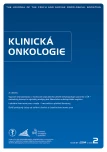On the Importance of Standardization in the Assessment of Population‑based Cancer Patient Survival in the Czech Republic – Methodology and Results from the Czech National Cancer Registry
Authors:
M. Uher 1; T. Pavlík 1; O. Májek 1; J. Mužík 1; T. Büchler 2; J. Abrahámová 2; R. Vyzula 3; J. Fínek 4; J. Vorlíček 3; L. Dušek 1
Authors‘ workplace:
Institut biostatistiky a analýz, MU, Brno2 Onkologická klinika 1. LF UK a Thomayerova nemocnice, Praha3 Klinika komplexní onkologické péče, Masarykův onkologický ústav, Brno4 Onkologické a radioterapeutické oddělení, FN Plzeň
1
Published in:
Klin Onkol 2014; 27(2): 127-135
Category:
Original Articles
Overview
Background:
Calculating 5‑year overall and relative survival is the standard method for population‑based analyses in oncology. Survival rates based on population data do not, however, guarantee standardized benchmarks for comparison of different patient populations, which is especially true when compared populations differ considerably in age structure and representation of clinical stages. In this paper, we present and compare statistical methods for standardization of cancer survival rates.
Patients and Methods:
Using data of the Czech National Cancer Registry, we estimated 5‑year overall and relative survival estimates for periods 2001 – 2005 and 2006 – 2010. To demonstrate the effect of standardization, we calculated crude and age ‑ standardized survival rates as well as survival rates standardized for both age and clinical stage.
Results:
Our results show that the particular standardization method influences resulting 5‑year overall and relative survival rates regarding both within and between time periods comparisons. In addition, our results document a recent improvement in 5‑year relative survival between periods 2001 – 2005 and 2006 – 2010 for 19 of 20 evaluated diagnoses. All most prevalent cancers including prostate, lung, colorectal, breast, kidney, and uterine cancer and melanoma were observed among the diagnoses with statistically significantly improved patient survival.
Conclusion:
Unless the use of standardization to the age and stage of tumor is limited due to a small number of patients in individual age ‑ and stage ‑ specific subgroups, this method can be considered as a proper statistical methodology for the population assessment of Czech cancer patient survival rates.
Key words:
medical oncology – survival analysis – relative survival – neoplasm staging – adjusted estimate
Sources
1. Clerc L, Jooste V, Lejeune C et al. Cost of care of colorectal cancers according to health care patterns and stage at diagnosis in France. Eur J Health Econ 2008; 9(4): 361 – 367.
2. Berrino F, De Angelis R, Sant M et al. Survival for eight major cancers and all cancers combined for European adults diagnosed in 1995 – 99: results of the EUROCARE ‑ 4 study. Lancet Oncol 2007; 8(9): 773 – 783.
3. Verdecchia A, Francisci S, Brenner H et al. Recent cancer survival in Europe: a 2000 – 02 period analysis of EUROCARE ‑ 4 data. Lancet Oncol 2007; 8(9): 784 – 796.
4. Coleman MP, Quaresma M, Berrino F et al. Cancer survival in five continents: a worldwide population‑based study (CONCORD). Lancet Oncol 2008; 9(8): 730 – 756.
5. Dušek L, Pavlík T, Mužík J et al. Populační standardy relativního přežití onkologických pacientů v ČR kalkulované z dat NOR – reakce na výsledky publikované ve studii EUROCARE 4. Klin Onkol 2007; 20(6): 399 – 404.
6. Dušek L, Pavlík T, Koptíková J et al. Národní onkologický registr ČR jako zdroj referenčních standardů pro hodnocení výsledků léčebné péče. Klin Onkol 2007; 20 (Suppl 1):77 – 95.
7. Brenner H, Soderman B, Hakulinen T. Use of period analysis for providing more up ‑ to ‑ date estimates of long‑term survival rates: empirical evaluation among 370.000 cancer patients in Finland. Int J Epidemiol 2002; 31(2): 456 – 462.
8. Ederer F, Axtell LM, Cutler SJ. The relative survival rate: a statistical methodology. Natl Cancer Inst Monogr 1961; 6 : 101 – 121.
9. Corazziari I, Quinn M, Capocaccia R. Standard cancer patient population for age standardising survival ratios. Eur J Cancer 2004; 40(15): 2307 – 2316.
10. Berrino F, Brown C, Moller T et al (eds). ENCR Recommendation. Condensed TNM for coding the extent of disease. Lyon: European Network of Cancer Registries 2002.
11. Marubini E, Valsecchi MG (eds). Analysing survival data from clinical trials and observational studies. New York: John Wiley & Sons 2004.
12. Hakulinen T. Cancer survival corrected for heterogeneity in patient withdrawal. Biometrics 1982; 38(4): 933 – 942.
13. Mortality.org [homepage on the internet]. The Human Mortality Database. University of California, Berkeley (USA), and Max Planck Institute for Demographic Research (Germany). Available from: www.mortality.org; www.humanmortality.de.
14. Klein JP, Logan B, Harhoff M et al. Analyzing survival curves at a fixed point in time. Stat Med 2007; 26(24): 4505 – 4519.
15. Brenner H, Arndt V. Further enhanced monitoring of cancer patient survival by stage ‑ adjusted period analysis. Cancer Epidemiol Biomarkers Prev 2005; 14(8):1917 – 1921.
16. Brenner H, Gondos A, Arndt V. Recent major progress in long‑term cancer patient survival disclosed by modeled period analysis. J Clin Oncol 2007; 25(22): 3274 – 3280.
17. Dusek L et al (eds). Czech Cancer Care in Numbers 2008 – 2009. Praha: Grada Publishing 2009.
18. Verdecchia A, Guzzinati S, Francisci S et al. Survival trends in European cancer patients diagnosed from 1988 to 1999. Eur J Cancer 2009; 45(6): 1042 – 1066.
Labels
Paediatric clinical oncology Surgery Clinical oncologyArticle was published in
Clinical Oncology

2014 Issue 2
Most read in this issue
- Psychoneuroimmunology in Context of Comprehensive Breast Cancer Treatment
- Renal Oncocytoma with Invasive Histopathologic Features – Case Report
- Continuing Progress in Withdrawal of Axillary Dissection in Early Stage Breast Cancer
- Lobular Breast Cancer in Man – Case Report and Review of the Literature
